
Houston is the most populous city in the U.S. state of Texas, fourth-most populous city in the United States, most populous city in the Southern United States, as well as the sixth-most populous in North America, with an estimated 2019 population of 2,320,268. Located in Southeast Texas near Galveston Bay and the Gulf of Mexico, it is the seat of Harris County and the principal city of the Greater Houston metropolitan area, which is the fifth-most populous metropolitan statistical area in the United States and the second-most populous in Texas after the Dallas–Fort Worth metroplex, with a population of 7,066,141 in 2019. Houston is the southeast anchor of the greater megaregion known as the Texas Triangle.

This article documents the wide-ranging history of the city of Houston, the largest city in the state of Texas and the fourth-largest in the United States.

Downtown is the largest business district in Houston, Texas, located near the geographic center of the metropolitan area at the confluence of Interstate 10, Interstate 45, and Interstate 69. The 1.84-square-mile (4.8 km2) district, enclosed by the aforementioned highways, contains the original townsite of Houston at the confluence of Buffalo Bayou and White Oak Bayou, a point known as Allen's Landing. Downtown has been the city's preeminent commercial district since its founding in 1836.
The Port of Houston is one of the world's largest ports and serves the metropolitan area of Houston, Texas. The port is a 50-mile-long complex of diversified public and private facilities located a few hours' sailing time from the Gulf of Mexico. Located in the fourth-largest city in the United States, it is the busiest port in the U.S. in terms of foreign tonnage, second-busiest in the U.S. in terms of overall tonnage, and sixteenth-busiest in the world. Though originally the port's terminals were primarily within the Houston city limits, the port has expanded to such a degree that today it has facilities in multiple communities in the surrounding area. In particular the port's busiest terminal, the Barbours Cut Terminal, is located in Morgan's Point.

The University of Houston–Downtown (UHD) is a public university in Houston, Texas. It is part of the University of Houston System. Its campus spans 40 acres (16 ha) in Downtown Houston, with a satellite location in northwestern Harris County. Founded in 1974, UHD is the second-largest university in the Houston area with more than 14,000 students.

Buffalo Bayou is a slow moving body of water which flows through Houston in Harris County, Texas. Formed 18,000 years ago, it has its source in the prairie surrounding Katy, Fort Bend County, and flows approximately 53 miles (85 km) east through the Houston Ship Channel into Galveston Bay and the Gulf of Mexico. In addition to drainage water impounded and released by the Addicks and Barker reservoirs, the bayou is fed by natural springs, surface runoff, and several significant tributary bayous, including White Oak Bayou, Greens Bayou, and Brays Bayou. Additionally, Buffalo Bayou is considered a tidal river downstream of a point 440 yards (400 m) west of the Shepherd Drive bridge in west-central Houston.

The Houston Ship Channel, in Houston, Texas, is part of the Port of Houston, one of the busiest seaports in the world. The channel is the conduit for ocean-going vessels between Houston-area terminals and the Gulf of Mexico, and it serves an increasing volume of inland barge traffic.
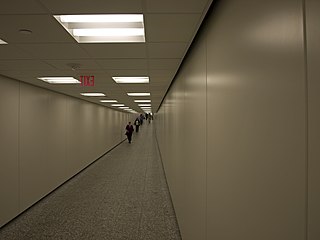
The Houston tunnel system is a network of subterranean, climate-controlled, pedestrian walkways that links 95 full city blocks 20 feet (6 m) below Houston's downtown streets. It is approximately 6 miles (9.7 km) long. There are similar systems in Chicago, Dallas, Oklahoma City, Montreal and Toronto. Architectural historian Stephen Fox has stated that the idea for the tunnel system came when the Bank of the Southwest Building was "linked by tunnel to the 1010 Garage and the Mellie Esperson Building" in 1961.

UH–Downtown is a station on the METRORail Red Line in Houston, Texas (USA) and it is the former northern terminus of the Red Line, since the line was extended in late 2013. The station is located on top of the Main Street viaduct at the campus of the University of Houston–Downtown (UHD).

The Houston Theater District, a 17-block area in the heart of Downtown Houston, Texas, United States, is home to Houston's nine professional performing arts organizations, the 130,000-square-foot (12,000 m2) Bayou Place entertainment complex, restaurants, movies, plazas, and parks. More than two million people visit the Houston Theater District annually.
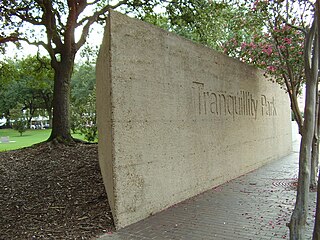
Tranquillity Park is a park in Downtown Houston, Texas, between Walker and Rusk Streets, and west of Smith Street, with the United States federal courts building for the Southern District of Texas on one side and Houston City Hall on the other. It takes its name, notably differing in spelling, from the Sea of Tranquility, where man first landed on the Moon during the Apollo 11 mission on July 20, 1969. First opening to visitors in the summer of 1979, Tranquillity Park was officially dedicated on the tenth anniversary of the historic lunar landing. On bronze plaques placed along the main entrance, the first words transmitted by Neil Armstrong from the Moon, "Houston, Tranquillity Base here. The Eagle has landed," are written in 15 languages. A replica of one of the footprints left on the Moon by Neil Armstrong is also on display inside the park.
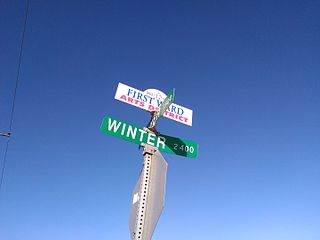
The First Ward of Houston, which is located inside the 610 Loop, is one of the city's historic wards. It was originally the center of the business district for the city, and was strategically located at the intersection of Buffalo Bayou and White Oak Bayou, near an area now known as Allen's Landing. It was one of the original four wards in Houston when it was created in 1840. It was defined as all area within the city limits of Houston north of Congress Street and west of Main Street.
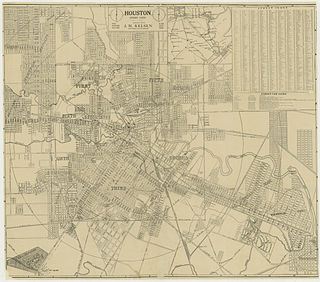
When the city of Houston was founded in 1836 and incorporated in 1837, its founders—John Kirby Allen and Augustus Chapman Allen—divided it into political geographic districts called "wards". The ward system, a precursor to today's City Council districts, was a common political tool of the early 19th century, and is still used in some American cities. When the system was at its peak, the city had six wards, from the first to the sixth.

Houston, the most populous city in the Southern United States, is located along the upper Texas Gulf Coast, approximately 50 miles (80 km) northwest of the Gulf of Mexico at Galveston. The city, which is the ninth-largest in the United States by area, covers 601.7 square miles (1,558 km2), of which 579.4 square miles (1,501 km2), or 96.3%, is land and 22.3 square miles (58 km2), or 3.7%, is water.

Allen Parkway is an arterial road west of Downtown Houston, Texas. It has a distance of approximately 2.3 miles (3.7 km), running from Interstate 45 west to Shepherd Drive, where it becomes Kirby Drive. Originally known as Buffalo Parkway, it was later named after John Kirby Allen and Augustus Chapman Allen, the founders of Houston.

White Oak Bayou is a slow-moving river in Houston, Texas. A major tributary of the city's principal waterway, Buffalo Bayou, White Oak originates near the intersection of Texas State Highway 6 and U.S. Highway 290 and meanders southeast for 25 miles (40 km) until it joins Buffalo Bayou in Downtown. The river serves as a greenway which connects Downtown to the Houston Heights, Oak Forest, Garden Oaks, and Inwood Forest.
The Houston Dragon Boat Festival is held in Houston, Texas. The Houston Dragon Boat Festival is a race down Buffalo Bayou, using decorated canoes called "dragon boats".

The One Main Building, formerly the Merchants and Manufacturers Building, is a building on the campus of the University of Houston–Downtown. The building is recognized as part of the National Register of Historic Places, is a Recorded Texas Historic Landmark, and considered a Contributing Building in Downtown Houston's Main Street/Market Square Historic District. The building was built above Allen's Landing—an area where Houston's founders John Kirby Allen and Augustus Chapman Allen originally settled.
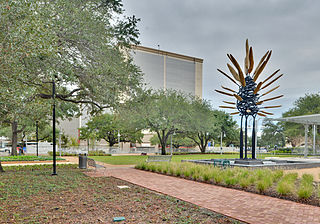
Main Street Market Square Historic District is a historic district in Houston that includes the Market Square Park. It includes buildings nearby, as well as the square itself. It was listed on the National Register of Historic Places in 1983.
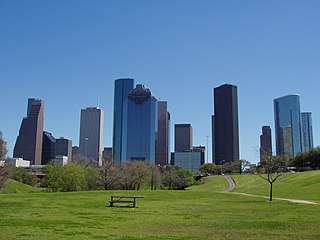
Eleanor Tinsley Park is a section of Buffalo Bayou Park in Houston, Texas. It was designated on April 20, 1998 in honor of Eleanor Tinsley, who served as a member of the Houston City Council At-Large for 16 years.





















